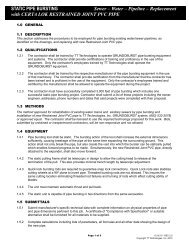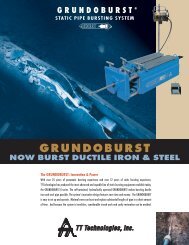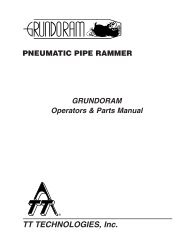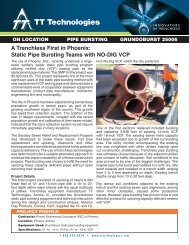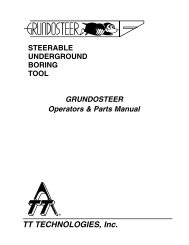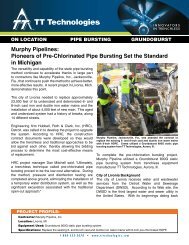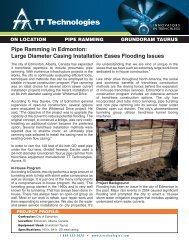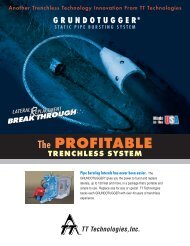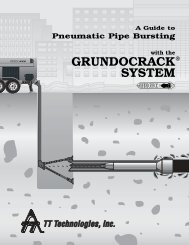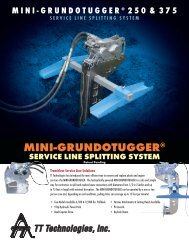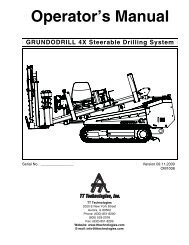Pipe Ramming in the Thin Air: BTrenchless Goes Large Diameter
Pipe Ramming in the Thin Air: BTrenchless Goes Large Diameter
Pipe Ramming in the Thin Air: BTrenchless Goes Large Diameter
Create successful ePaper yourself
Turn your PDF publications into a flip-book with our unique Google optimized e-Paper software.
un-off from <strong>the</strong> San Juan Mounta<strong>in</strong> Range, through<br />
town of Pagosa Spr<strong>in</strong>gs and <strong>in</strong>to <strong>the</strong> San Juan River.<br />
Cont<strong>in</strong>uous flow through <strong>the</strong> culvert has made <strong>the</strong><br />
s<strong>in</strong>khole a significant problem. The edge of <strong>the</strong> s<strong>in</strong>khole<br />
was only 25 feet from <strong>the</strong> north shoulder of west bound<br />
US 160 and <strong>the</strong> portion of <strong>the</strong> exist<strong>in</strong>g culvert under<br />
Highway 160 was so deteriorated that <strong>the</strong> Colorado<br />
Dept. of Transportation (CDOT) determ<strong>in</strong>ed that <strong>the</strong><br />
pipe needed to be replaced.<br />
with repeated percussive blows. A cutt<strong>in</strong>g shoe is often<br />
welded to <strong>the</strong> front of <strong>the</strong> lead cas<strong>in</strong>g to help reduce<br />
friction and cut through <strong>the</strong> soil. Bentonite or polymer<br />
lubrication can also be used to help reduce friction<br />
dur<strong>in</strong>g ramm<strong>in</strong>g operations. <strong>Ramm<strong>in</strong>g</strong> tools, <strong>in</strong> general,<br />
are capable of <strong>in</strong>stall<strong>in</strong>g 4- through 147-<strong>in</strong>ch diameter<br />
pipe and steel cas<strong>in</strong>gs.<br />
<strong>Ramm<strong>in</strong>g</strong> can be used for horizontal, vertical, and even<br />
angled applications. It is often used under roads, like<br />
<strong>the</strong> Pagosa project, and rail l<strong>in</strong>es because it displaces<br />
<strong>the</strong> soil without creat<strong>in</strong>g voids or slumps.<br />
Accord<strong>in</strong>g to TT Technologies pipe ramm<strong>in</strong>g specialist<br />
Rick Melv<strong>in</strong> that is a key benefit of pipe ramm<strong>in</strong>g. He<br />
said, “Some <strong>in</strong>stallation methods can jeopardize <strong>the</strong><br />
<strong>in</strong>tegrity of roads or rail l<strong>in</strong>es because <strong>the</strong>y remove soil<br />
from underneath to allow for <strong>the</strong> new pipe <strong>in</strong>stallation.<br />
<strong>Pipe</strong> ramm<strong>in</strong>g’s ability to <strong>in</strong>stall various sized cas<strong>in</strong>gs<br />
without putt<strong>in</strong>g <strong>the</strong> topside structures <strong>in</strong> danger makes<br />
it a very attractive option. Also pipe ramm<strong>in</strong>g works <strong>in</strong><br />
difficult soil conditions. Boulders and rocks, as large as<br />
<strong>the</strong> cas<strong>in</strong>g itself, can be swallowed up as <strong>the</strong> cas<strong>in</strong>g<br />
moves through <strong>the</strong> soil and can be removed after <strong>the</strong><br />
<strong>in</strong>stallation is complete.”<br />
Dur<strong>in</strong>g <strong>the</strong> pipe ramm<strong>in</strong>g process, a pneumatic hammer is attached to<br />
<strong>the</strong> rear of <strong>the</strong> cas<strong>in</strong>g or pipe.<br />
Wellensiek said, “As <strong>the</strong> ma<strong>in</strong> artery between Pagosa<br />
Spr<strong>in</strong>gs and Durango, Colo, Highway160 is a very busy<br />
two lane highway and CDOT did not want to impact<br />
traffic by open cutt<strong>in</strong>g <strong>the</strong> highway to <strong>in</strong>stall a new<br />
culvert. Open cutt<strong>in</strong>g was really never an option. We<br />
would have had to perform that type of work late at<br />
night when traffic levels were as low as possible.”<br />
Ultimately, plans were drawn up to ram an 84-<strong>in</strong>ch<br />
diameter steel cas<strong>in</strong>g over <strong>the</strong> deteriorat<strong>in</strong>g 60-<strong>in</strong>ch<br />
CMP culvert and encase it. The exist<strong>in</strong>g CMP would<br />
<strong>the</strong>n be removed from <strong>the</strong> steel cas<strong>in</strong>g and a new 60-<br />
<strong>in</strong>ch RCP l<strong>in</strong>e <strong>in</strong>stalled. The <strong>BTrenchless</strong> crew would<br />
face many challenges <strong>in</strong> order to make that happen.<br />
<strong>Pipe</strong> <strong>Ramm<strong>in</strong>g</strong> 101<br />
Dur<strong>in</strong>g <strong>the</strong> pipe ramm<strong>in</strong>g process, a pneumatic<br />
hammer is attached to <strong>the</strong> rear of <strong>the</strong> cas<strong>in</strong>g or pipe.<br />
The ramm<strong>in</strong>g tool, which consists of a piston with<strong>in</strong> a<br />
cas<strong>in</strong>g, drives <strong>the</strong> pipe or cas<strong>in</strong>g through <strong>the</strong> ground<br />
An entire length of pipe can be <strong>in</strong>stalled at once or,<br />
for longer runs, one section at a time can be <strong>in</strong>stalled.<br />
In that case, <strong>the</strong> ramm<strong>in</strong>g tool is removed after each<br />
section is <strong>in</strong> place and a new section is welded on to <strong>the</strong><br />
end of <strong>the</strong> newly <strong>in</strong>stalled section. The ramm<strong>in</strong>g tool is<br />
connected to <strong>the</strong> new section and ramm<strong>in</strong>g cont<strong>in</strong>ues.<br />
Several methods can be used to remove spoil from <strong>the</strong><br />
cas<strong>in</strong>g <strong>in</strong>clud<strong>in</strong>g compressed air, water, an augur<strong>in</strong>g<br />
system or o<strong>the</strong>r types of earthmov<strong>in</strong>g equipment.<br />
High and Not So Dry<br />
One of <strong>the</strong> first challenges Wellensiek and <strong>the</strong><br />
<strong>BTrenchless</strong> crew faced was elevation. Wellensiek said,<br />
“Pagosa Spr<strong>in</strong>gs sits at an elevation of 7,100 feet above<br />
sea level. That has a direct impact on <strong>the</strong> capacity of<br />
your air compressor system.”<br />
Ano<strong>the</strong>r difficult aspect of <strong>the</strong> project was ma<strong>in</strong>ta<strong>in</strong><strong>in</strong>g<br />
dra<strong>in</strong>age flow through <strong>the</strong> exist<strong>in</strong>g culvert while<br />
ramm<strong>in</strong>g. Wellensiek said, “At times <strong>the</strong>re was really<br />
low flow. Twice dur<strong>in</strong>g this project we were completely<br />
flooded out because of ra<strong>in</strong> and <strong>the</strong>re was no way to<br />
handle that amount of water. So basically we stopped,<br />
and got out of <strong>the</strong> way. There was noth<strong>in</strong>g else we<br />
could do.”<br />
On <strong>the</strong> Job<br />
<strong>BTrenchless</strong> crews excavated a ramm<strong>in</strong>g pit on <strong>the</strong><br />
1 - 8 0 0 - 5 3 3 - 2 0 7 8 • w w w . t t t e c h n o l o g i e s . c o m



